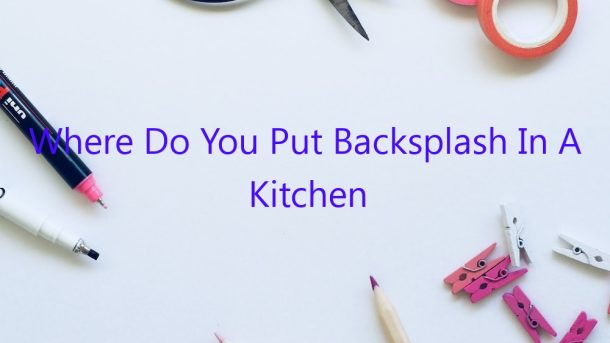A backsplash is a great way to protect your kitchen walls from spills and splatters. But where do you put a backsplash in a kitchen? Below are some tips on how to choose the right location for your kitchen backsplash.
When deciding where to put a backsplash in your kitchen, consider the function of the space. If you cook a lot, you may want to put the backsplash behind the stove or sink to protect the walls from splatters. If you don’t cook as much, you may want to put the backsplash in a more visible location, such as above the countertops or behind the fridge.
Another thing to consider when choosing a location for your kitchen backsplash is the style of your kitchen. If your kitchen has a modern or contemporary style, a backsplash in a bold color or pattern may be a good choice. If your kitchen has a more traditional style, a backsplash in a neutral color or a simple design may be a better fit.
Once you’ve decided on a location for your kitchen backsplash, it’s time to start thinking about the design. You can either choose a backsplash that matches the countertops or cabinets, or you can choose a backsplash that stands out and contrasts with the other elements in the kitchen. You can also choose a backsplash that complements your appliances or kitchen hardware.
No matter what style or design you choose, be sure to consider the materials and colors that will be most compatible with your kitchen. Glass, stone, and ceramic tiles are all popular choices for kitchen backsplashes, and they come in a variety of colors and styles.
Once you’ve chosen a backsplash design and materials, it’s time to get started on the installation. Most kitchen backsplashes can be installed by a DIY enthusiast, but it’s always a good idea to consult with a professional before starting any major home renovation project.
Thanks for reading! I hope this article helped you understand the basics of kitchen backsplashes and gave you some ideas for your own kitchen renovation project.
Contents
Should backsplash go to end of counter or cabinet?
There is no definitive answer to this question as it depends on personal preference and the design of your kitchen. Some people prefer to have the backsplash extend all the way to the end of the counter, while others prefer to have it stop at the edge of the cabinet.
There are a few things to consider when making this decision. First, consider the materials you are using for the backsplash and countertop. If you are using a material that is prone to staining or water damage, it may be a good idea to have the backsplash extend all the way to the end of the counter. This will help to protect the counter from any potential damage.
Another thing to consider is the overall design of your kitchen. If you have a modern, minimalist kitchen, it may look better if the backsplash stops at the edge of the cabinet. This will create a clean, streamlined look. If you have a more traditional or eclectic kitchen, however, it may look better if the backsplash extends all the way to the end of the counter.
Ultimately, it is up to you to decide what looks best in your kitchen. If you are having trouble deciding, ask a professional kitchen designer for advice. They will be able to help you create a kitchen that is both beautiful and functional.
Where do you apply backsplash?
A backsplash is a decorative tile or panel that is installed behind a stove, sink, or other countertop surface. Backsplashes can be made from a variety of materials, including ceramic, stone, or metal.
There are a few things to consider when choosing a backsplash material. First, think about the style of your kitchen. If your kitchen is modern and minimalist, a simple ceramic tile may be the best option. If your kitchen has a more traditional or rustic look, a stone or metal backsplash may be a better choice.
Another important consideration is how much upkeep you are willing to do. Ceramic tiles are relatively easy to clean, but stone and metal backsplashes can be a bit more difficult. If you are not willing to do regular cleaning and maintenance, a ceramic tile may be a better option.
Finally, think about your budget. Backsplashes can be expensive, but there are a variety of options available depending on your budget.
Once you have decided on a material, the next step is to decide where to install the backsplash. The most common places to install a backsplash are behind the stove and the sink. But you can also install a backsplash along the entire countertop surface.
If you are installing a ceramic tile backsplash, it is important to have a professional install it. Ceramic tiles can be tricky to install and require a lot of precision. If you are not comfortable installing the tiles yourself, it is best to hire a professional.
If you are installing a stone or metal backsplash, you may be able to do it yourself. However, it is always best to consult with a professional to make sure you are doing it correctly.
Overall, there are a lot of factors to consider when choosing a backsplash material. But with a little bit of research, you can find the perfect backsplash for your kitchen.
Do all kitchen walls need backsplash?
A kitchen backsplash is a great way to protect your walls from spills and splashes. It can also add color and personality to your kitchen. But do all kitchen walls need backsplash?
The answer to that question depends on your kitchen. If your kitchen has a lot of cabinets and appliances that extend to the ceiling, a backsplash may not be necessary. However, if your kitchen has an open layout or is exposed to a lot of moisture, a backsplash is a must.
There are a variety of materials you can use for a kitchen backsplash, including tile, metal, glass, and stone. If you’re not sure which material is right for your kitchen, consult a professional.
A kitchen backsplash can be a great way to add personality to your kitchen. If you’re not sure whether or not your kitchen needs a backsplash, consult a professional.
Do you put backsplash on side walls?
Do you put backsplash on side walls?
Backsplash is a material that is typically used to protect walls from moisture and stains. It is most commonly used in the kitchen, where it protects the walls from food splatters and grease. But can you also use backsplash on side walls?
The answer is yes, you can use backsplash on side walls. However, it is not always necessary. In general, you should use backsplash on side walls if the walls are exposed to moisture or if they are susceptible to stains. If the walls are not exposed to moisture or if they are not susceptible to stains, then you may not need to use backsplash.
If you do decide to use backsplash on side walls, there are a few things to keep in mind. First, you will need to choose the right type of backsplash. There are a variety of different types of backsplash, including tile, stone, and metal. You will need to choose a type that matches the style of your home and the material of your walls.
Second, you will need to install the backsplash correctly. This can be a bit tricky, so it is important to hire a professional to do the job. The professional will need to measure the walls correctly and install the backsplash in a way that prevents moisture and stains from reaching the walls.
If you are thinking about using backsplash on side walls, the best thing to do is to consult a professional. They will be able to help you choose the right type of backsplash and install it correctly.
Do you put backsplash behind stove?
Do you put backsplash behind stove?
The answer to this question depends on the type of stove you have. If you have a gas stove, the backsplash should go behind the stove, not above it. If you have an electric stove, the backsplash can go either behind or above the stove.
Most people put the backsplash behind the stove because it is easier to clean. If you put it above the stove, food and grease can drip onto it and it will be difficult to clean.
Where should backsplash begin and end?
There are a few things to consider when deciding where to put your kitchen backsplash. One of the most important factors is deciding where the backsplash should begin and end.
The backsplash should always begin at the countertop and end at the bottom of the cabinets. This will help protect your walls from food and grease stains. It will also help keep your kitchen looking neat and tidy.
If you have a tile backsplash, be sure to start and end the tile at the countertop and cabinet line. This will create a neat and polished look.
If you’re using a different type of backsplash, such as vinyl or wallpaper, be sure to follow the manufacturer’s instructions for installation.
It’s also important to consider the height of your backsplash. The backsplash should be at least 4-6 inches high, but no more than 12 inches high.Anything taller than 12 inches can be a distraction and will block your view of the stovetop.
When deciding where to put your kitchen backsplash, be sure to keep these things in mind. By following these guidelines, you can create a beautiful and functional backsplash that will perfectly complement your kitchen.
Does backsplash go behind stove?
There is some debate over whether or not a backsplash should go behind a stove. Some people believe that it is necessary in order to protect the walls from the heat and splatters from the stove. Others believe that it is not necessary and can actually create more of a mess.
The main purpose of a backsplash is to protect the walls from getting dirty and wet. This is especially important in areas where there is a lot of cooking activity, such as the kitchen. The backsplash can be made from a variety of materials, including tile, stainless steel, or plastic.
When it comes to the stove, there are a few things to consider. The most important is the height of the stove. The backsplash should be high enough so that it will protect the walls from the heat and splatters from the stove. It should also be wide enough so that it will cover the entire area behind the stove.
Another consideration is the type of stove. If you have a gas stove, the backsplash should be made from a material that can withstand the heat. If you have a electric stove, the backsplash can be made from a variety of materials, including tile, stainless steel, or plastic.
Overall, it is up to the homeowner to decide whether or not they want a backsplash behind their stove. If they are concerned about protecting the walls from the heat and splatters, then they should install a backsplash. If they are not concerned about this, then they can choose not to install a backsplash.




